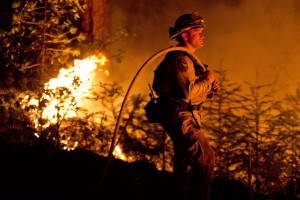WSJ Historically Speaking: Fire as a Source of Destruction—and Innovation
Wildfire season officially began in September, but the long drought in parts of the U.S. has made the idea of a specific season seem almost redundant. According to the National Interagency Fire Center, the U.S. has already suffered 41,000 wildfires this year, resulting in the loss of 3.1 million acres.
Although fire remains one of the greatest dangers to human life, throughout history, its devastating power has been a source of both inspiration and innovation.
In 24 B.C., the constant threat of city fires led the Roman Emperor Augustus to institute the Cohortes Vigilum, the first municipal fire department. Its 7,000 freedmen acted as watchmen, day and night. Although Rome’s six-story wooden buildings and narrow streets made actual firefighting all but impossible, the Cohortes Vigilum helped make the city a safer place. If necessary, it had the authority to knock down whole streets—a crude but effective form of fighting fires.
A major fire had not erupted for 28 years when, on the night of July 19, 64 A.D., a sudden blaze broke out in one of the shops beneath the Circus Maximus. Emperor Nero was vacationing by the sea, and the city’s two million inhabitants were under the eye ofFlavius Sabinus, the city prefect. Sabinus managed to save the senatorial archives, but he was helpless against the firestorm that engulfed Rome. It took six days for the fire to burn itself out. By then, 10 of the city’s 14 regions were damaged or in ruins. The fire left rich and poor homeless; even Nero’s palace on Palatine Hill, the Domus Transitoria, suffered damage.
But the city was transformed after the fire. Not only did Nero build the ancient Rome that is remembered today—with its broad avenues, pedestrian arcades and travertine buildings—he also decreed the first fire codes, including height restrictions and public water supplies.
Nero’s example was imitated by Charles II after the Great Fire of London in September 1666. This fire also began in a shop—a bakery in Pudding Lane, near London Bridge. As with Rome, the fire raged unchecked for several days. By the end, some 373 acres, 13,200 houses and 84 churches had been destroyed. The original medieval walled city was in ruins, with more than 100,000 people homeless.
In October, King Charles II appointed commissioners, including the great architect Sir Christopher Wren, to oversee London’s rebuilding. History repeated itself with the introduction of height restrictions. The repair effort refashioned the city from a labyrinth of wooden alleys into a grand design of elegant squares and streets. The 17th-century poet John Dryden marveled at the change: “More great than human now and more august, / Now deified she from her fires does rise: / Her widening streets on new foundations trust.”
A similar determination to improve and renew followed the Great Chicago Fire that began on Oct. 8, 1871. No rain had fallen for almost a month, and some two-thirds of Chicago’s 60,000 buildings were made entirely of wood. High winds created 100-foot-high flame devils that tore through the city. By the time the fire petered out, some 300 lives had been lost, along with the equivalent of 73 miles of streets.
In the aftermath, known as the Great Rebuilding, a group of architects formed the First Chicago School, which introduced a raft of techniques such as fireproofed steel framing. Out of Chicago’s ashes rose the pioneering skyscraper, the Home Insurance Building. The world would never be the same. As the poet Carl Sandburg wrote, “The skyscraper looms in the smoke and the stars and has a soul.”

